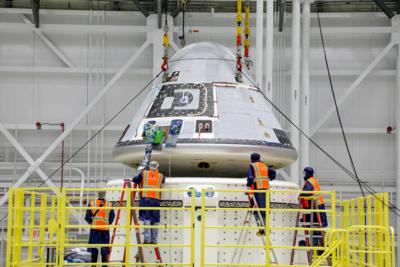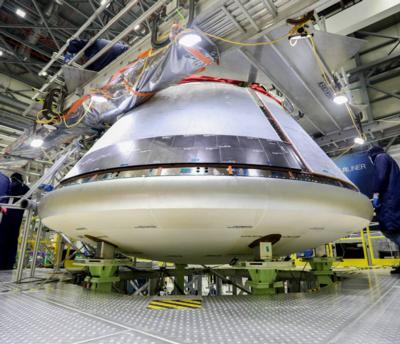Mon, Mar 08, 2021
Winter Storms and Avionics Replacements Take The Blame
NASA and Boeing are evaluating a new target launch date for the CST-100 Starliner’s Orbital Flight Test-2 (OFT-2) to the International Space Station after winter storms in Houston, and the recent replacement of avionics boxes, set the program back about two weeks. NASA also is weighing the volume of verification and validation analysis required prior to the test flight and the visiting vehicle schedule at the International Space Station.

Previously, the launch was targeted for no earlier than April 2.
An important factor the teams are evaluating is the visiting vehicle schedule at the International Space Station, which already has a scheduled crewed Soyuz launch and NASA’s SpaceX Crew-2 mission in April. Based on the current traffic at the space station, NASA does not anticipate that OFT-2 can be accomplished later in April. NASA and Boeing are working to find the earliest possible launch date.
“Boeing and NASA have worked extremely hard to support an early-April launch but we need to assess alternatives to ensure NASA’s safety work can be accomplished. NASA and Boeing know we fly together,” said Kathy Lueders, associate administrator, NASA’s Human Exploration and Operations Mission Directorate. “Boeing has done an incredible amount of work on Starliner to be ready for flight and we’ll provide an update soon on when we expect to launch the OFT-2 mission.”

“I’m grateful for the extraordinary work being undertaken by our NASA partners as we progress towards our OFT-2 mission,” said John Vollmer, vice president and program manager of Boeing’s Commercial Crew Program. “And I’m very proud of the Boeing Starliner team for working so diligently to get the hardware, software and certification closure products ready for flight. We’re committed to demonstrating the safety and quality of our spacecraft and progressing to our crewed test flight and the missions beyond.”
The company has been conducting dry-runs ahead of an end-to-end mission rehearsal that will allow the operations team to practice and observe integrated interactions through the whole mission profile, from launch to docking and undocking to landing. Additionally, power-on testing and checkouts of the OFT-2 vehicle, with new avionics boxes installed, have been completed successfully. Spacecraft fueling operations and the stacking of the launch vehicle are also ready to commence.
More News
19-Year-Old Pilot Was Attempting to Fly Solo to All Seven Continents On his journey to become the first pilot to land solo on all seven continents, 19-year-old Ethan Guo has hit a >[...]
From 2017 (YouTube Edition): A Quality LSA For Well Under $100k… Aeroprakt unveiled its new LSA at the Deland Sport Aviation Showcase in November. Dennis Long, U.S. Importer>[...]
Hazardous Weather Information Summary of significant meteorological information (SIGMET/WS), convective significant meteorological information (convective SIGMET/WST), urgent pilot>[...]
Aero Linx: Historic Aircraft Association (HAA) The Historic Aircraft Association (HAA) was founded in 1979 with the aim of furthering the safe flying of historic aircraft in the UK>[...]
"We would like to remember Liam not just for the way he left this world, but for how he lived in it... Liam was fearless, not necessarily because he wasn't afraid but because he re>[...]
 TikToker Arrested After Landing His C182 in Antarctica
TikToker Arrested After Landing His C182 in Antarctica Classic Aero-TV: Versatile AND Practical - The All-Seeing Aeroprakt A-22 LSA
Classic Aero-TV: Versatile AND Practical - The All-Seeing Aeroprakt A-22 LSA ANN's Daily Aero-Term (06.27.25): Hazardous Weather Information
ANN's Daily Aero-Term (06.27.25): Hazardous Weather Information ANN's Daily Aero-Linx (06.27.25)
ANN's Daily Aero-Linx (06.27.25) Aero-News: Quote of the Day (06.27.25)
Aero-News: Quote of the Day (06.27.25)




